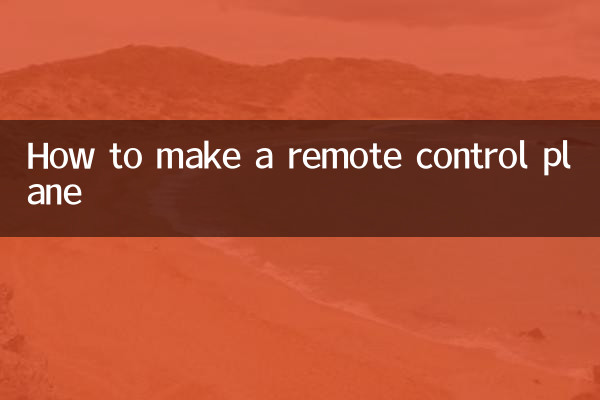Title: How to make a remote-controlled aircraft
In the past 10 days, the hottest discussions on remote-controlled aircraft across the network have continued to rise, especially the tutorials and material purchases of DIY remote-controlled aircraft have become popular topics. This article will combine recent hot topics to provide you with a detailed guide to making remote-controlled aircraft, covering material preparation, assembly steps and debugging techniques, to help you easily complete your remote-controlled aircraft.
1. Recent hot topics and hot content

According to the search data of the entire network, the following are high-frequency keywords and popular content related to remote-controlled aircraft in the past 10 days:
| Keywords | Popularity index | Related content |
|---|---|---|
| DIY remote control aircraft | 85 | Production tutorials, material list |
| Remote control aircraft accessories | 78 | Motor, battery, remote control selection |
| Remote-controlled aircraft debugging | 65 | Flight stability and signal problems |
| 3D printing remote control aircraft | 72 | Model design, lightweight materials |
2. Steps for making remote control aircraft
1. Material preparation
The following core materials are required to make remote-controlled aircraft, and the recent combination of popular accessories is as follows:
| Material name | Recommended model | use |
|---|---|---|
| Brushless motor | XXD 2212 KV1400 | Provide power |
| Electronic speed regulator | Hobbywing 30A | Control motor speed |
| Lithium battery | 3S 2200mAh | powered by |
| Remote Control Set | FlySky FS-i6 | Control the plane |
| propeller | 1045 forward and reverse paddle | Generate thrust |
2. Assembly process
Step 1: Rack building
The body frame is made using light wood or carbon fiber rods, and the 3D printing modular design has been popular recently. The wingspan length is recommended to be 60-80cm, and the motor installation position is reserved at the nose.
Step 2: Power system installation
Fix the motor to the head, fix the electronic speed controller with a tie, and connect three wires of the motor (the sequence can be adjusted subsequently). The battery compartment should be close to the center of gravity.
Step 3: Control system connection
Fix the receiver in the middle of the fuselage and connect it in turn:
- Channel 1: Aileron servo
- Channel 2: Elevator
- Channel 3: throttle cable (connected to electric regulator)
- Channel 4: Rudder (optional)
3. Debugging and flying test skills
According to recent hot topics of discussion among flying friends, special attention should be paid to debugging:
| Question Type | Solution | heat |
|---|---|---|
| Takeoff offset | Adjust the aileron fine adjustment/check the center of gravity | high |
| Insufficient motivation | Check battery voltage/propeller size | middle |
| Signal interference | Replace the 2.4GHz band/check the antenna | high |
4. Safety precautions
1. Choose an open windless field for the first test flight
2. Wear goggles and operate high-speed rotating propeller
3. Use explosion-proof bags when charging the battery
4. Comply with local drone flight regulations
Through the above steps, combined with recent popular technical solutions and accessories selection, you can complete a stable remote-controlled aircraft within 2-3 days. Remember to share the production process on social platforms, participate in the topic discussion of #DIY remote control aircraft#, and get more creative suggestions!

check the details

check the details